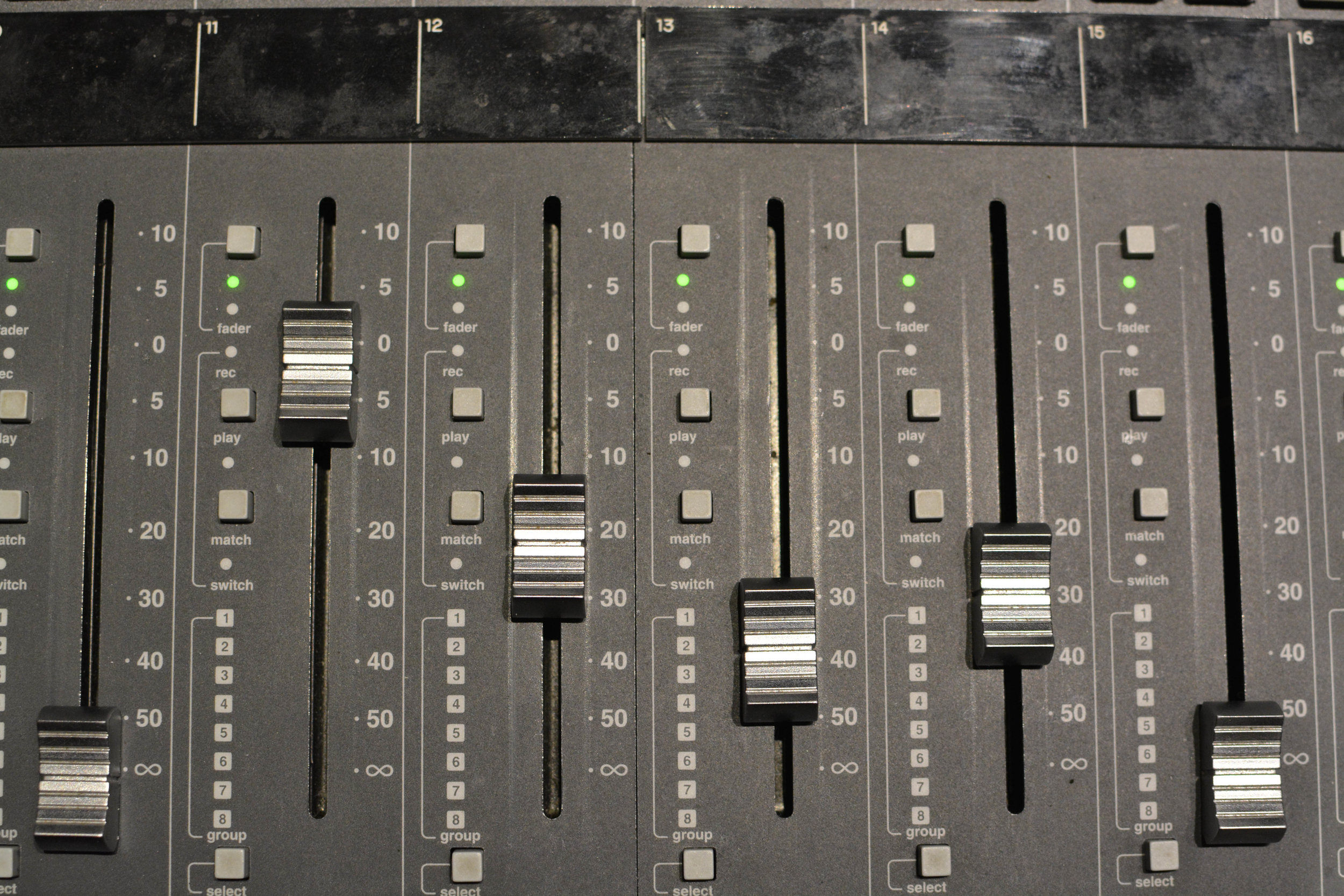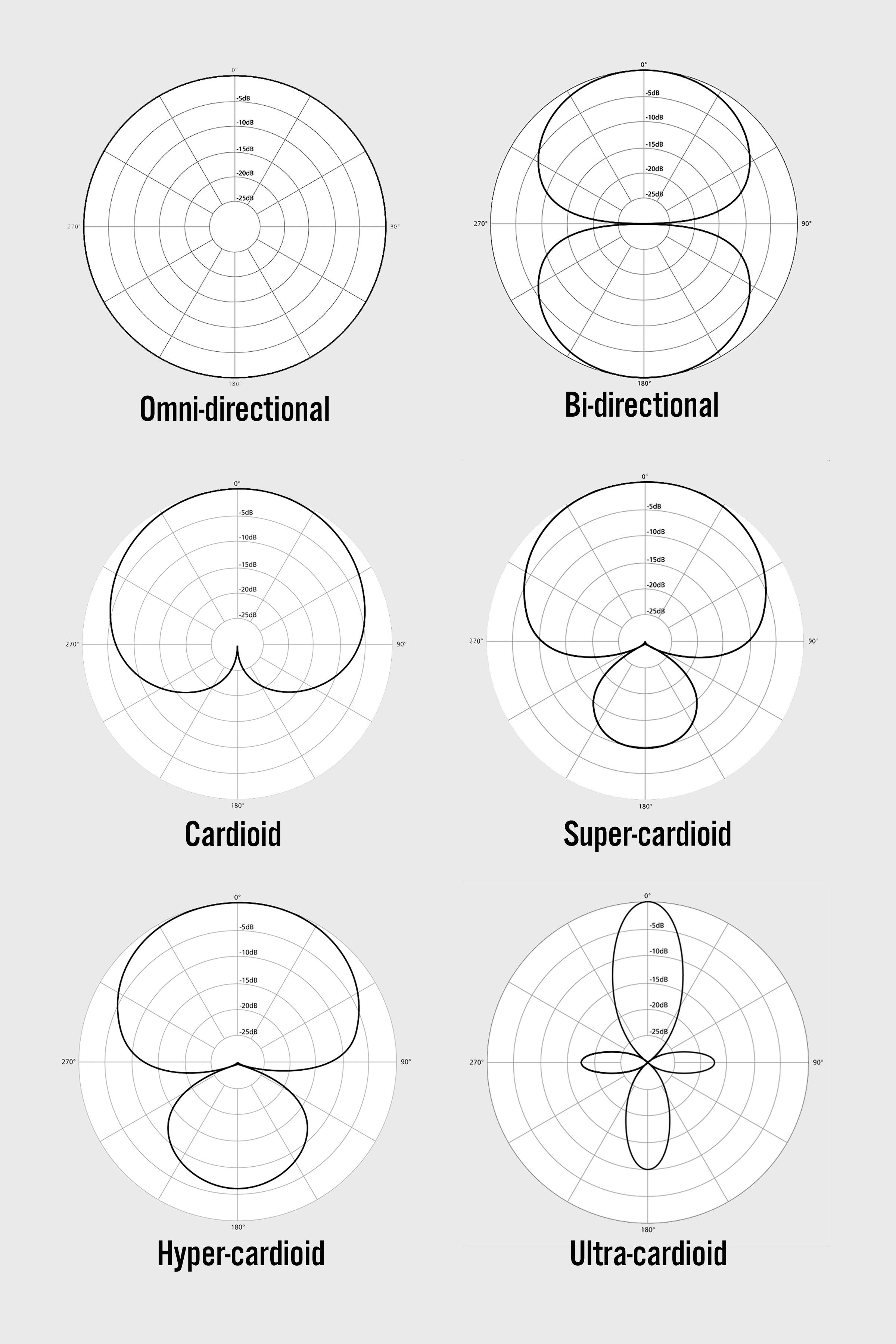A Beginner's Buying Guide to Microphones
/No matter what style of music you make or what you plan to record, you will almost certainly need some form of microphone. With so many different models and manufacturers, choosing the best microphone for the job can be difficult if you’re new to the world of recording. Check out this handy buying guide to find out what mic will work best for you.
How do Microphones Work?
All microphones do essentially the same thing: they convert acoustic energy to electrical energy. (i.e. they are a transducer). This signal is then manipulated further down the chain by other equipment and can be recorded into your computer.
Classifying Microphones by Polar Pattern
Arguably the most useful way of classifying microphones is by how they respond to sounds in their environment. This is referred to as the “polar pattern” of the microphone (see Fig. 1). Tighter polar patterns are often used in applications where room reverberations are not desirable or where there is a large amount of unwanted background noise (such as on a film set or at a concert). However, they also have a tendency to over-exaggerate low frequencies when positioned close to the sound source because of their directionality. This is known as the “proximity effect”. Wider polar patterns are often used in situations where picking up the room reverberation is desirable or where there is little or no background noise (such as a professional recording studio). Wider polar patterns are also used in situations where the proximity effect is undesirable.
Fig 1: The different microphone polar patterns. Note that manufacturers sometimes use the terms super-cardioid, hyper-cardioid, and ultra-cardioid relatively loosely, so when buying these microphones always look at the technical diagrams to ensure it fulfills your needs.
Omni-directional – Picks up sound evenly from all directions
Bi-directional – Picks up sound from the front and rear of the microphone while rejecting sound on the sides
Cardioid – Picks up sound in front of the microphone while rejecting sound to the rear and, to some degree, the sides
Super-cardioid – Similar to cardioid but with a narrower field of frontal pickup and more side rejection, at the cost of adding a small amount of rear pickup
Hyper-cardioid – Has a narrower field of frontal pickup and more side rejection than a super-cardioid, but also has a larger rear field of pickup
Ultra-cardioid – Also called a shotgun microphone, has a very narrow frontal field of pickup and very strong side rejection, but a larger rear field of pickup than the hyper-cardioid
Classifying Microphones by Construction
Microphones can also be classified by how they convert acoustical energy to electrical energy. Microphone construction as a whole is far too technical to delve into here, but the practical applications that arise from it are important.
Moving coil dynamic - generally less sensitive to transients (fast sounds), and highly durable. As a result, they are frequently used in live sound applications and on percussive or loud instruments.
Condenser - more sensitive to transients and generally less durable, but provides a much greater level of sonic detail than the average moving-coil dynamic microphone. Condenser microphones require phantom power (a voltage sent through the microphone cable) to operate.
Ribbon - technically a form of dynamic microphone, but they behave quite differently than moving-coil dynamics. They tend to sound relatively dark, full and detailed, but are very delicate and susceptible to damage from loud transients and phantom power.
My Recommendations
I get asked about microphones a lot and there's a handful of microphones that I usually recommend to those new to recording. Since the microphone is the first thing in your signal path, you want to make sure that you are recording using a high quality microphone. While I have seen microphones priced as low as $20, most if not all of them are noisy, poorly built, and sound terrible. Everything on this list is durable, easy to use, and sounds good for its price point. I can't stress enough that microphones are one of those pieces of equipment where you get what you pay for.
Shure SM57
(Dynamic, Cardioid)
In my opinion, everyone should own an SM57. They’re highly versatile microphones that have been used in both studio and live applications for decades. Their best uses include placement on guitar amps or snare drums, but I’ve also seen them used on everything from bass amps to hand percussion. SM57s are practically indestructible and I’ve seen them get stepped on, kicked over, and even dropped off stages without sustaining more than a couple scratches. They come in at around $100 USD, making them an affordable choice and a perfect mic for a gigging musician that records at home.
Rode NT1A
(Condenser, Cardioid)
This is the microphone I recommend most often to beginning engineers, hobbyists, and musicians recording at home. It’s very affordable, retailing for $250 USD, and it blows everything else in its price range out of the water. My favourite use for the NT1A is recording clean electric guitar tones because of its brightness, but it’s also great for recording vocals and acoustic guitar, or as a drum overhead mic. These often come as a part of a kit that includes a shockmount, pop filter, and cable, meaning that you have almost everything you need to get started.
AKG C214
(Condenser, Cardioid)
The C214 is another reasonably priced (approximately $350 USD) condenser microphone and probably the most direct competitor on this list to the Rode NT1A. Compared to the NT1A, the C214 has a more balanced sound, as well as a pad and high-pass filter, making it a bit more versatile. I would recommend this microphone for vocals, acoustic guitar, and any other acoustic stringed instrument (for example, banjo or mandolin). It also makes a good drum mic for toms or overheads due to its high SPL (sound pressure level) tolerance.
Audio-Technica AT4050
(Condenser, Multi-Pattern)
This could be the flagship microphone of most home/project studios and is frequently used by commercial studios. It’s one of my favourite mics and I’ve used it on pretty much everything including vocals, violin, piano, acoustic guitar, banjo, clean electric guitar, hand percussion and voiceover, and it consistently sounds excellent. It’s expensive, coming in at roughly $700 USD, but the switchable polar patterns make it incredibly flexible and the quality is a step above the other microphones on this list when it comes to picking up subtle sonic details.
Shure SM7B
(Dynamic, Cardioid)
This is another microphone that could easily be a flagship microphone for a home studio, but for roughly half the price of the AT4050. Originally intended for broadcast use, the SM7B was adopted by rock, metal and hip-hop vocalists for its ability to tame aggressive vocals that can sound harsh on other microphones. At a $400 USD price point, it has been a staple of both professional and home studios alike. It’s most commonly used for voiceover, vocals and electric guitar amps. The “presence boost” switch is great for adding clarity to vocals and making them cut through a mix.
Rode NTG-2
(Dynamic, Shotgun)
I would recommend this microphone for anyone looking to get started in film/TV sound or the audio post-production industry. The NTG-2 is a shotgun microphone that can take an AA battery to provide phantom power while in the field, has a switchable high pass filter to remove excess low end at the source, and is cheap enough at $270 USD that it would be relatively easy to replace if damaged. It can hold its own for voiceover in the studio and you can easily find hot shoe mounts to attach it to a camera for fast-paced shooting situations like interviews.
The Home Studio Archive is reader-supported. When you buy from links on our website we may earn a small commission at no additional cost to you. We do not accept compensation for reviews and only recommend products we have used and tested ourselves.
Buy It Now
Amazon
Shure SM57 (click here for Canadian Price)
Rode NT1A (click here for Canadian Price)
AKG C214 (click here for Canadian Price)
Audio-Technica AT4050 (click here for Canadian Price)
Shure SM7B (click here for Canadian Price)
Rode NTG2 (click here for Canadian Price)
Hot Shoe Mic Mount Kit (click here for Canadian Price)








